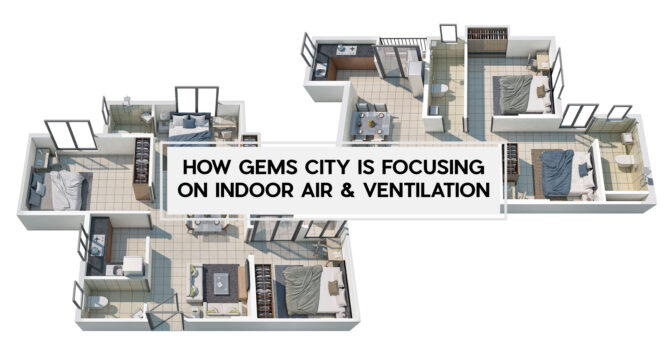BlogsAll about beautiful living
- Categories
How Kolkata’s leading residential projects is focusing on indoor air

With work from home (WFH) and online learning becoming a widely accepted mantra post-COVID, people are spending a major part of their time indoors; and when not at home, they are working, learning or chilling in enclosed, built-up spaces. You could say that a major percentage of our time is being spent indoors.
In developing Gems City near Joka Metro in Kolkata, Gems Group was fully conscious of the necessity to ensure a comfortable, productive and healthy indoor environment for all residents. The only way to do that was by following design practices that considered temperature, lighting, noise pollution, proper ventilation and last, but not the least, quality of indoor air. The latter is especially important, since contrary to what we might think, air pollution is much higher indoors than outdoors.
Airborne chemical pollutants
Indoor air can, not only cause discomfort and affect productivity, but it could very well become a potential threat for a resident’s health as it could hold a wide range of airborne and gaseous pollutants. Architects and urban designers have to contend with the fact that these elements tend to manifest in immediate surroundings, embedded in construction, finishing or even daily use household materials. Increased levels of exposure to them can cause health issues such as asthma and infections. In fact, almost half of all respiratory illnesses are caused or aggravated by poor indoor air quality. Toxic gaseous chemicals and high levels of carbon dioxide (CO2) created by respiring inhabitants, tobacco smoke or even household appliances can be the silent sources too.
Threats from airborne pathogens
The Covid pandemic has underscored the ubiquity of health risks from airborne pathogens. Indoor pathogens might be microorganisms such as fungi and moulds, which tend to grow in wet, warm environments (70% to 95% humidity) and release spores into the air, contributing to their spread and potentially harming a resident’s health. Other types of microorganism pathogens are bacteria, which are living organisms that are found all around us, whether on surfaces, air, on dust or in water. While most are generally safe, some species can be harmful. They can emanate from outdoor air, from daily materials brought into the home or from poorly maintained ventilation systems. Viruses like Covid constitute the third form of pathogen contaminants. They are also usually brought into the home from exterior sources.
As a leading property developer, Gems Group recognises that apart from personal hygiene, most indoor air pollutants and pathogens can be significantly minimised by adequate air circulation and ventilation; which is addressed by architecture and design.
How can architecture and design help?
Good architecture and design are the most important means of reducing and controlling the growth of indoor air pathogens and pollutants. Proper ventilation, exposure to natural light, building envelope insulation and sustainably sourced non-toxic material are among the practices adopted by Gems Group while implementing their residential project at Gems City. Proper natural ventilation is one of the first considerations while designing a home. Orientation of the building and a well-studied layout of openings to promote effective airflow are the way forward.
In addition, choosing best-in-class material is one of the most effective ways to mitigate the propagation of indoor air contaminants. It can reduce and remove pollution sources from harmful and volatile chemicals by using non-toxic modern materials that have been created for contemporary indoor constructions, keeping in mind healthful living as an imperative that has earned its rightful place under the sun.
You Might Like...
-
 28 August, 2024
28 August, 2024Understanding Kolkata’s Joka Real Estate Trend: A Conversation between Friends
Avijit and Sailesh had been friends since their college days...more
-
 22 August, 2024
22 August, 2024Affordable Housing Projects in Joka South Kolkata: Finding Your Perfect Apartment
he demand for affordable housing projects in Joka South Kolkata has increased...more
